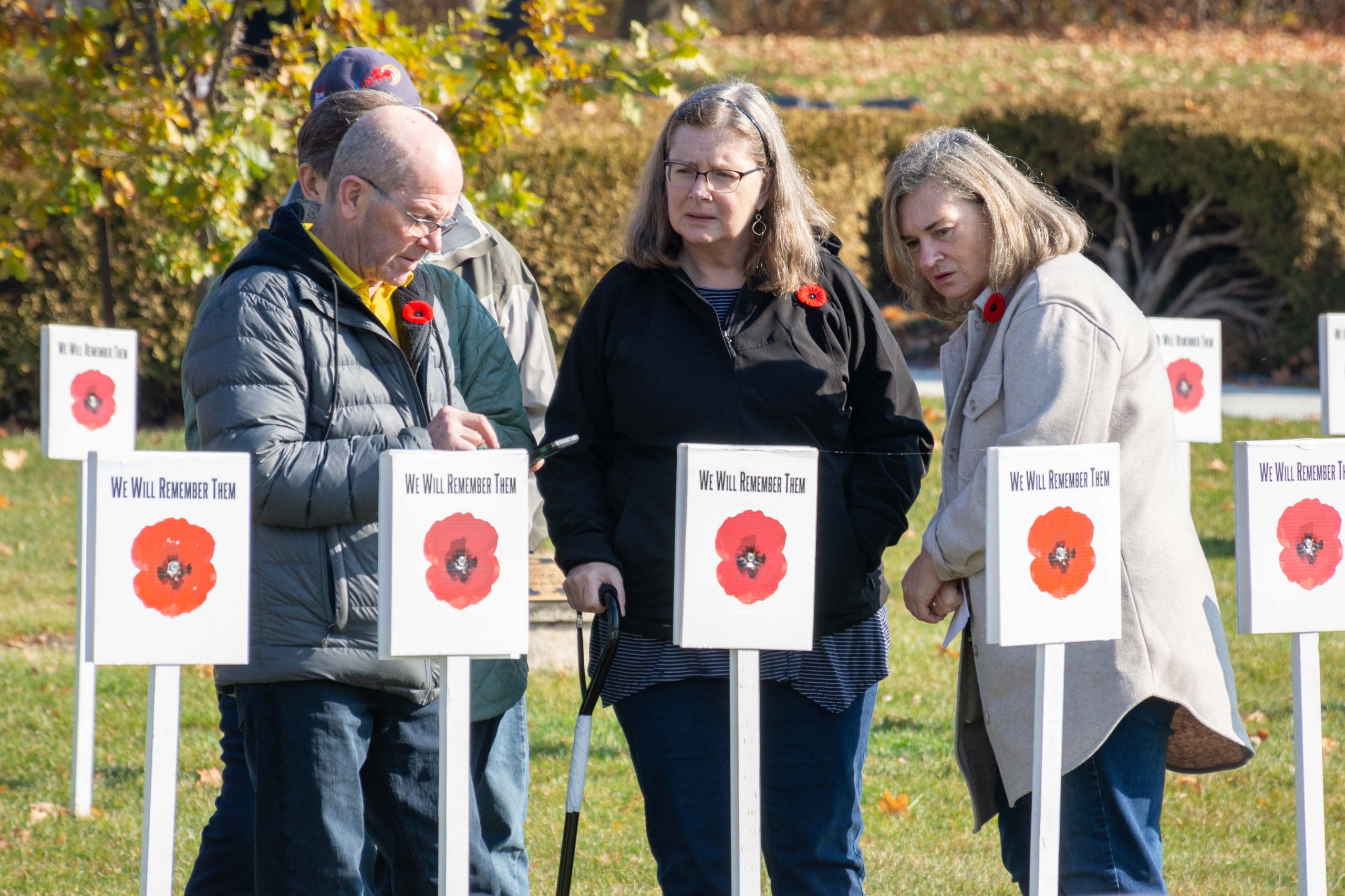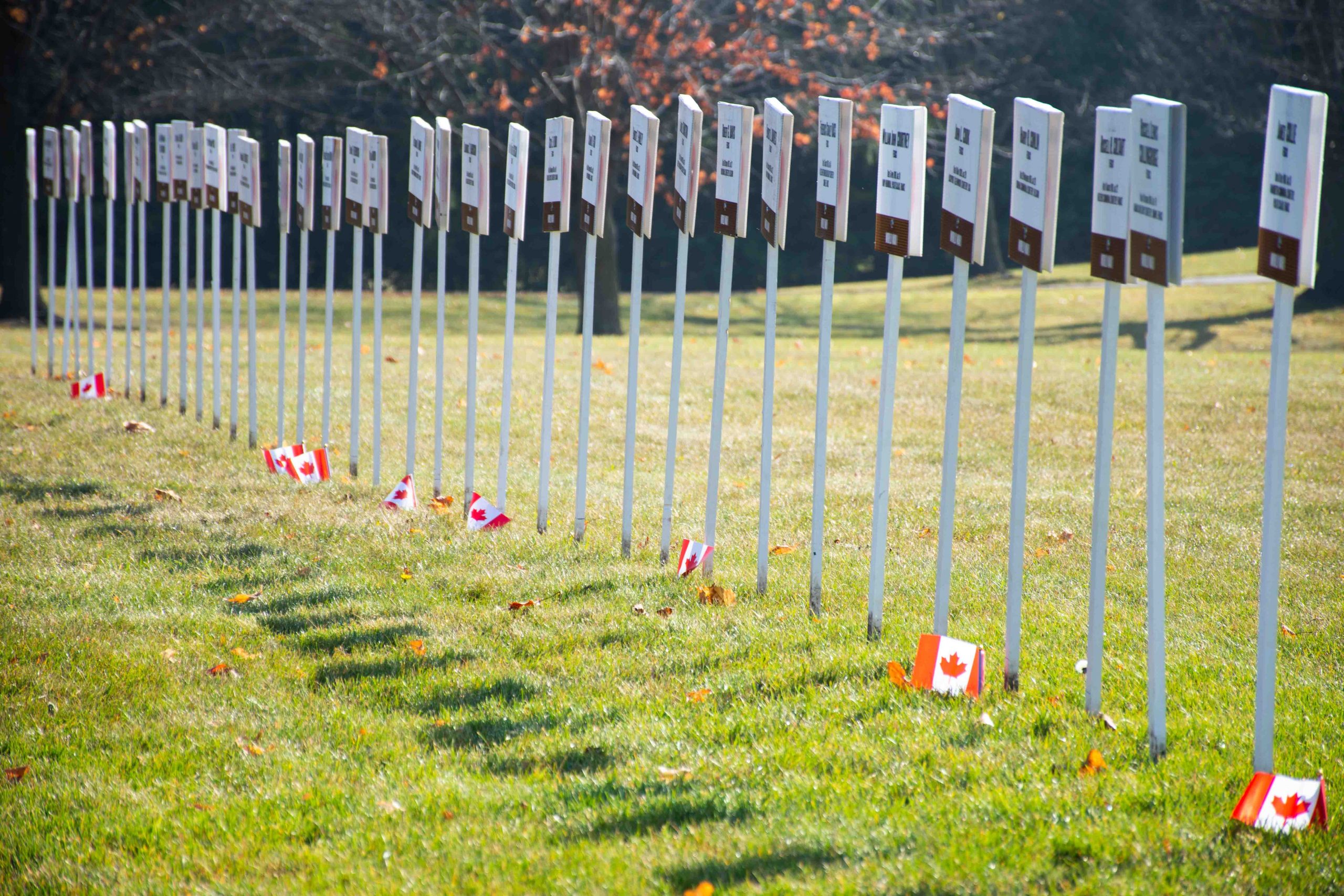ABOYNE – With the start of November comes a marker of remembrance that has become an important tradition on the sprawling lawn of the Wellington County Museum and Archives, (WCMA).
The We Will Remember Them display places over 500 memorial markers, each commemorating one of Wellington County’s fallen, from the First World War to Afghanistan.
The visual impact is powerful and staff at the museum hope it will encourage people to tour the display and take the time to read the names and learn their stories.
Kyle Smith, WCMA activity programmer, hopes the display gives visitors perspective into the scope of the loss and the impact it would have had on local communities at the time.
“We’re a small community and in 1914 we were even smaller than that,” Smith said.
“And to see, just for WWI, you see so many names that are on there, and they’re all separated by townships, like Arthur, Fergus and whatnot, and just the amount, and it’s not wounded … It’s the war dead from all those tiny little places. And it’s in just four years.
“It’s overwhelming to see them all in one place,” he adds.
“It’s one thing to read a book, or read statistics, but when you see it staring you in the face, it’s a whole different thing.”
The annual display began in 2014, part of the Remembrance events for the 100th anniversary of the First World War.
“It expands every year. We do more research,” Smith said, estimating the current marker count is approximately 535. “Every year we find new names, family members come forward. So, we keep adding people.”
Telling the story behind each of the markers is a corresponding online database – Wellington County Remembers: Commemorating Our Fallen – that compiles research such as personal letters, attestation papers, service records and, where possible, images of the soldiers.
Archivist Karen Wagner explains, “The database is really an evolution of the resources we’ve been putting together over a number of years relating to the military history of Wellington County.”
She explains the database began around 2002 with the permanent First World War exhibit, Far from Home: A Soldier’s Life at the Front, which includes a bulkhead in the gallery listing the names of the soldiers on cenotaphs across Wellington County.
“Everyone who was listed on the cenotaph either died during the war, or within a few years after the war due to illness or injury as a result of the war,” Wagner said.
“There is only one woman in the database, a nurse named Alice Cook from Mount Forest.”
It was the creation of the memorial marker display that spurred the initiative to delve further into the history of these individual soldiers. As that research continued to evolve, so too did the database.
“I know one of the challenges for even putting the names on that bulkhead of all the individuals who are on the Cenotaph, was answering questions about why some individuals were listed on more than one cenotaph,” Wagner explained, noting in some cases, it was due to family connection in the area, or perhaps they had lived in several communities at different times in their lives.

John and Nancy Merrick, left and centre, and Terri Fitzpatrick inspect one of the markers bearing the names of Wellington County’s war dead at the Wellington County Museum and Archives on Nov. 3. Photo by Jordan Snobelen
“If you look at our database, we list the cemetery that they are buried in, and so many of them are overseas,” Wagner said.
“So I think it was very important for their communities to create the cenotaph memorials so that their family members would have a place to go to honour and remember them.”
Trying to include a photo with each soldier turned out to be “one of our biggest challenges,” Wagner said.
“It was interesting to see how many during the First World War had photos in the local newspapers. And that’s where we got a lot of images.”
The We Will Remember Them display serves as the backdrop for two important events: the remembrance ceremony on Nov. 3 and the candle light vigil on Nov. 10.
The Nov. 3 event has passed but on Nov. 10, a candle lighting service welcomes the community to gather at dusk to place a candle at the markers in tribute to the fallen.
“This is my favourite of all the services … because it’s so informal,” Smith said, noting the event draws groups like Cub Scouts, families, seniors, and veterans who enjoy the experience of reading the names of the soldiers, of honouring them with a candle, and seeing the display glow as night falls.
“It’s so nice, and we get such a great cross section of everybody.”
The event is open to everyone and begins at 5:30pm. Candles are provided by the museum. Those candles remain lit until Nov. 12.
Both events help Smith encourage visitors to learn more about the stories behind each name on the markers by making a personal connection to them.
“What I tell everybody to do in my remarks is to find one person either in the database or on the lawn, and if he’s got the name of your son, or he’s from your town, or shares your birthday … it doesn’t have to be a relative, or anything like that, but find one of them and keep them in your thoughts,” Smith said.
“If you use the database, you can learn about them. You can learn about how they died and what happened to them.”
Smith hopes the recommendation to connect the display and database together will bring local history to life.
“It’s just a way of making something that’s so big and so overwhelming, a little bit smaller,” he said.
“And I think that’s the beauty of the display. It seems so big, but then it’s small. It’s like one individual person each time, and then the database too, it’s this huge thing, but you can break it down to a really small level and bring it home a little bit easier.”
Wagner said there is much interest to include veterans who returned from the Second World War and have since passed.
It is a future goal for the museum to commemorate them, Wagner said.
The online database can be found at wellington.ca.
Did you know?
ABOYNE – In November 2020, the Wellington County Museum and Archives launched the virtual exhibit, Wellington County Remembers: Our Cenotaphs Unveiled.
Wellington County has 14 cenotaphs built between 1919 and 1956.
The exhibit tells the story of each community’s efforts to build the memorial, with a map that recognizes each site with the image of the Royal Canadian Legion’s Remembrance Poppy symbol.
The first cenotaph in Wellington County was built in Eramosa Township. The monument was completed and unveiled on Aug. 29, 1919, less than a year after Armistice Day.
The last cenotaph in Wellington County was unveiled in 1956 in the Town of Erin. Unique among the county’s war memorials, the Erin cenotaph was a gift to the Town of Erin from the Erin Branch of the Royal Canadian Legion.
A plaque on the memorial itself credits brothers Howard and Weir Winters, both World War II Royal Canadian Air Force veterans and the owners of Winters’ Garage in Erin.
Weir Winters was the President of the Erin Branch for many years.
For more details on local cenotaphs, visit wellington.ca and click on Maps for the Explore Wellington County options: Wellington County Remembers: Our Cenotaphs Unveiled.



